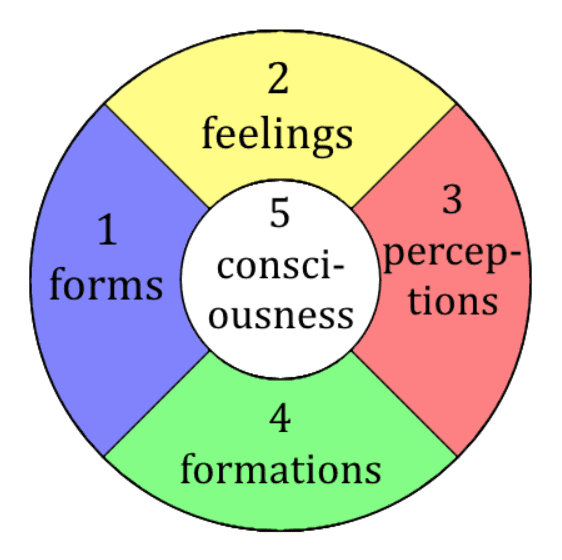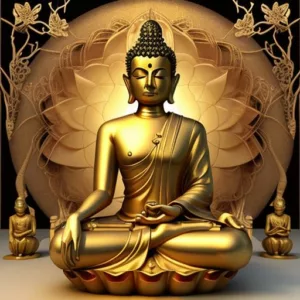Meaning of the five aggregates in Buddhism

5 skandhas simplified: In Buddhism, the 5 skandhas (heaps or aggregates) are the constituent pieces of the self, the being, the personality.
They are form, feeling, perception, formations, and consciousness. They are falsely conceived as a truly existent, singular, independent self, which does not exist.
Table of Contents
Secrets of Meditation for Anxiety
Like millions of people, you may have suffered from anxiety for years. Meditation, yoga, peaceful music – it never works. It takes too long, and it’s not stable. Why? Because peace is treated as a cause for freedom, but it’s not – it’s the result. The cause to free yourself from anxiety is completely different.
Click now to Overcome Anxiety for good.
Five Skandhas
Attributes:
- Definition: Five aggregates that constitute a sentient being’s experience of reality
- Origin: Buddhist philosophy
- Components:
- Rupa (Form): Physical and sensory experiences
- Vedanā (Sensation): Pleasant, unpleasant, or neutral experiences
- Saññā (Perception): Recognition and categorization of experiences
- Samkhāra (Mental Formations): Volitional and reactive mental processes
- Vijñāna (Consciousness): Cognitive awareness of experiences
Relationships:
Is Part Of:
- Buddhism
A detailed guide to the 5 skandhas
The twelve Nidanas and the 5 Skandhas are summarized in the Pratītyasamutpāda mantra or the mantra of dependent origination:
OM YE DHARMA HETU-PRABHAVA HETUM TESHAM TATHAGATO HYAVADAT TESHAM CHA YO NIRODHA EVAM VADI MAHASHRAMANAH SVAHA.
Shariputra, a student of the Buddha, was asked to summarize the Buddha’s teaching, and he said this. It means, according to Nalanda Translation:
Regarding dharmas that arise from a cause, the Tathagata taught their cause and also their cessation. Those were the words of the Great Mendicant.
The 5 skandhas are important because they comprise the essential trap of samsara. Studying and meditating on them allows liberation. From this perspective of relative truth, all is impermanent and interconnected by causes and conditions. The skandhas and the nidanas are interconnected. My image is the nidanas are a track and the skandhas are the train. Or the nidanas are a movie and the skandhas are a single frame.
The five skandhas constitute the components of the self and the composite of the personality. Skandhas means aggregates or heaps. It’s important to realize they are constantly changing. They do not stay still. The skandhas build from a more graspable, almost material reality to more abstraction and more ungraspable.
How to meditate like a yogi
and enter profound samadhi
Characteristics of the 5 Skandhas
The skandhas have several characteristics, according to the Buddha. They are not singular, but composed of many parts, hence the name aggregates. They lack essence or any core element. They are non-solid, unfixed. Hence they are in perpetual flux, constant motion. Grasping onto the skandhas as a self creates suffering. It is conditioned and being separated from the unconditioned truth, automatically generates the pain of separation. Knowing the skandhas allows for realization through meditation on not-self. This state is called soso tharpa, individual liberation. It is Nirvana, the state of non-returning to being.
Breakout of the 5 Skandhas
- Form / Rupa-skandha: This is the sense of perceiving a physical existence in the form of one’s body and in the form of external objects. At a purified level, form becomes vajra body. Form has also been called Form-Ignorance by Trungpa Rinpoche. Ignorance is the fundamental ignorance of reality. Form here is not a truly existent thing. It is an appearance and we create the concept.
For example, there is a grey area between a bush and tree. But the ignorance is deeper than this for it is ignorance of fundamental reality, an ignorance of emptiness or shunyata, that things lack inherent existence. From the skandhas perspective, this ignorance is not knowing the lack of the truly existent self.
- Feelings / Vedana-skandha: Also, translated as Sensations. It is a sense of encountering external reality at some basic, fundamental level. The perceived feels either Pleasure, Pain or Indifference (neutrality) about the perception.
The activity extended from Feeling becomes Passion, Aggression, and Delusion, the 3 poisons. Passion is wanting a thing. Aggression is dislike, wanting something to go away. The neutral sensation can be regarded as ignorance, but not the root level ignorance – not knowing. This is more of not paying attention.
- Perception / saṃjñā-skandha: Perception is the name or concept applied without noticing to forms. We apply concepts to it and solidify it into specific forms: cars, trees, rocks, houses, people, etc, but these things do not exist in a discrete sense as physical objects per se. They are not singular, they are composed of many parts. They are not permanent, they will not last. They are not independent, existing from their own side. They exist as the objects we perceive only in the mind. The idea of a tree is the real tree, a sort of idealized image of a tree that we apply to the perceptions. Perception means both the sensory appearances and the names applied to them.
- Formation / Samskara-skandha: Samskaras are mental structures or states, immaterial aspects of the mind. They can be activities and are grouped into several baskets. The abhidharma lists a total of 51 samskaras. The first set are the five ever present mental factors. They are always active when conscious, even in dreams:
- Sensation
- Perception
- Intention
- Contact
- Attention
The five object determining factors assess external phenomena:
- Interest
- Appreciation
- Mindfulness
- Concentration
- Intelligence
The eleven virtuous aspects. These are cultivated as activity:
- Faith
- Dignity
- Propriety
- Non-attachment
- Non-aggression
- Non-delusion
- Exertion
- Pliancy
- Conscientiousness
- Equanimity
- Nonviolence
Six Kleshas or Root Negative emotions. These are avoided in the Hinayana, seen as empty in the Mahayana, and meditated upon / purified as the deity or sacred mandala in the Vajrayana. They are NOT indulged in:
- Passion
- Aggression
- Ignorance
- Arrogance
- Doubt
- Wrong View
Four undecided states that can be positive, negative, or neutral. These are balanced and used properly for each path:
- Sleep
- Regret
- Conception
- Discernment
Twenty subsidiary destructive emotions (same as the Six Root Negative Emotions): Fury, Resentment, spite, envy, pretence, shamelessness, etc.
- Consciousness / Vijnana-skandha: This is the essential perceiver of everything. Consciousness is typically mistaken for a self. It cannot be a particular self because it is essentially only the ability to perceive. It is the same as anyone else’s consciousness. The difference arises in relation to the samskaras and their combinations and regarding the perceptions.
They further breakdown into the six or eight (depending on the system) consciousnesses. Five sensory consciousnesses and the mental consciousness, plus the afflicted consciousness and the alaya consciousness.
The five sense consciousnesses are eye, ear, nose, tongue, and touch. Mental consciousness is the awareness of mental events – concepts in the mind.
The ‘defiled’ consciousness (7th) is generally regarded as the seat of the self. Its essential function is to focus on the alaya consciousness and label it as the self. When the consciousnesses are purified through meditation on the view, the 7th consciousness and the 8th (alaya) dissolve. Realized beings / Buddhas do not have these.
The alayavijñana / storehouse consciousness holds the karmic seeds. It is a neutral consciousness, not active and not engaged in perception. More of an object than subject. Thus the 6th consciousness faces outward to perceptions and the 7th faces inward to the storehouse of alaya, the vast karmic reservoir of the person.
In Vajrayana, when the 5 skandhas are purified, they arise as the 5 primordial Buddhas. The consciousnesses become the 5 wisdoms.

Flow, the profound mental state, also called Peak Performance, can be attained with meditation and can be ‘triggered’ at will, with enough discipline. Guide to Flow Mastery will teach you how.
Meditation on the 5 Skandhas
To meditate on the five aggregates, study the meaning first. Establish a clear focus, bring one of the aggregates to mind, and examine your experience and being for it. See if that skandha is the self or ego. Doing this meditation for all the heaps can establish the correct view of selflessness.
What are the 5 skandhas in Buddhism?
Form, feeling, perception, formation, and consciousness are the five skandhas or aggregates that make up the self, according to the Buddha.
Why are the 5 skandhas important?
Contemplation and meditation on the 5 skandhas can lead to the realization of not-self, allowing the meditator to attain Nirvana.
What do the skandhas represent?
They represent the constituent pieces of the self according to Hinayana theory of Buddhism.
What is the point of the 5 aggregates?
Understand the construction of the ego.
What do 5 skandhas teach?
The self is an illusion based on aggregating the components into a seemingly solid, singular, lasting ‘self.’ It is a persistent, but false illusion.
Summary of the Five Skandhas
The 5 skandhas are the basic snapshot of the self at any point in time. They operate karmically, so to speak, via the 12 nidanas. The skandhas form a strategy to uphold the illusion of a permanent, independent, and unchanging self. Analyzing the skandhas, contemplating them, and meditating on them as actual experience yields the insight of not-self, the realization of arhatship. This is also called Nirvana, which is peace.

May all beings be happy
May all beings be peaceful
May all beings be safe
May all beings awaken to the light of their true nature
May all beings be free








